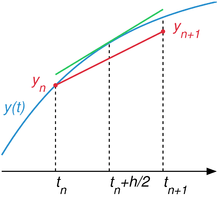Midpoint method

In numerical analysis, a branch of applied mathematics, the midpoint method is a one-step method for numerically solving the differential equation,
- .
The explicit midpoint method is given by the formula
the implicit midpoint method by
for Here, is the step size — a small positive number, and is the computed approximate value of The explicit midpoint method is also known as the modified Euler method,[1] the implicit method is the most simple collocation method, and, applied to Hamiltionian dynamics, a symplectic integrator.
The name of the method comes from the fact that in the formula above the function giving the slope of the solution is evaluated at which is the midpoint between at which the value of y(t) is known and at which the value of y(t) needs to be found.
The local error at each step of the midpoint method is of order , giving a global error of order . Thus, while more computationally intensive than Euler's method, the midpoint method's error generally decreases faster as .
The methods are examples of a class of higher-order methods known as Runge-Kutta methods.
Derivation of the midpoint method


The midpoint method is a refinement of the Euler's method
and is derived in a similar manner. The key to deriving Euler's method is the approximate equality
which is obtained from the slope formula
and keeping in mind that
For the midpoint methods, one replaces (3) with the more accurate
when instead of (2) we find
One cannot use this equation to find as one does not know at . The solution is then to use a Taylor series expansion exactly as if using the Euler method to solve for :
which, when plugged in (4), gives us
and the explicit midpoint method (1e).
The implicit method (1i) is obtained by approximating the value at the half step by the midpoint of the line segment from to
and thus
Inserting the approximation for results in the implicit Runge-Kutta method
which contains the implicit Euler method with step size as its first part.
Because of the time symmetry of the implicit method, all terms of even degree in of the local error cancel, so that the local error is automatically of order . Replacing the implicit with the explicit Euler method in the determination of results again in the explicit midpoint method.
See also
Notes
- ↑ Süli & Mayers 2003, p. 328
References
- Griffiths,D. V.; Smith, I. M. (1991). Numerical methods for engineers: a programming approach. Boca Raton: CRC Press. p. 218. ISBN 0-8493-8610-1.
- Süli, Endre; Mayers, David (2003), An Introduction to Numerical Analysis, Cambridge University Press, ISBN 0-521-00794-1.